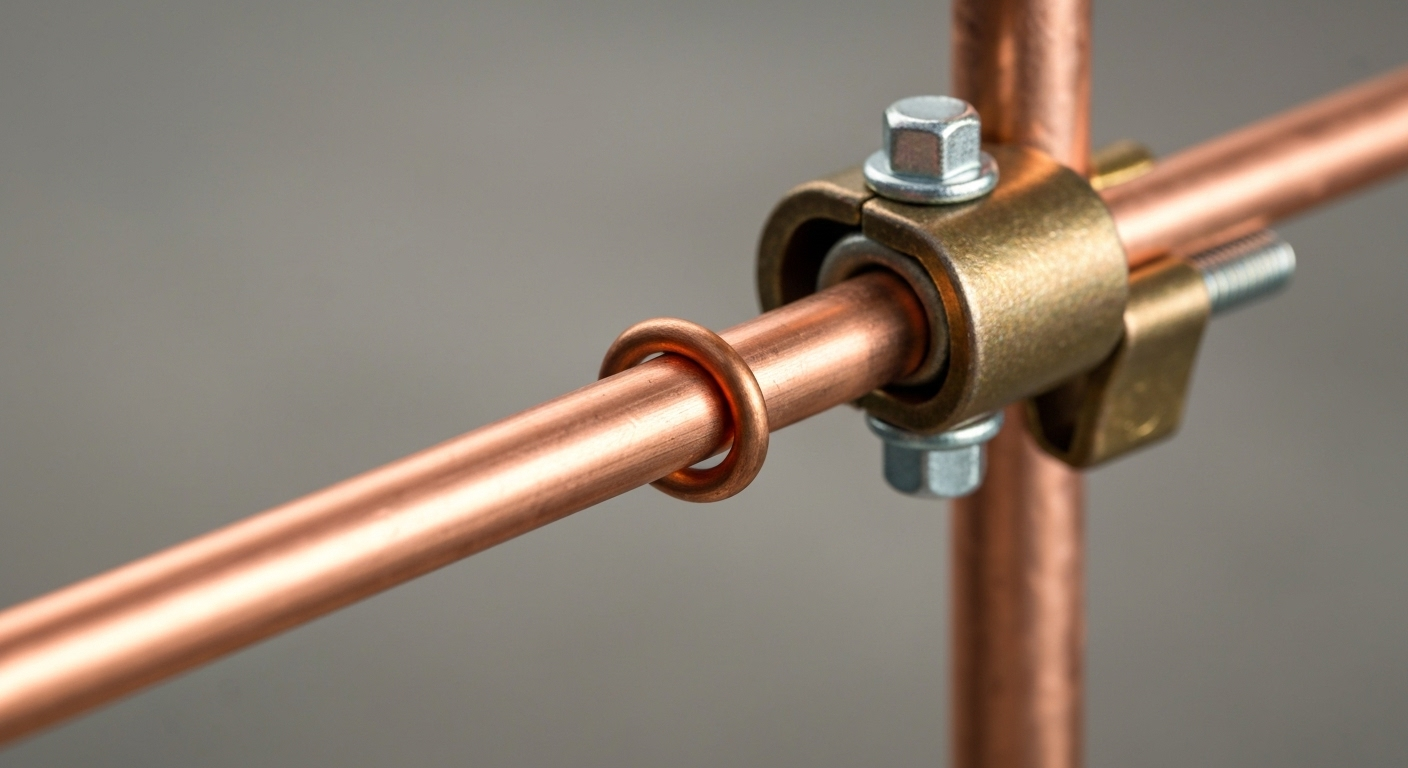
NEC 250.66 Grounding Electrode Conductor Sizing (2023 Update)
As a master electrician and certified NEC instructor, I’ve seen firsthand how misinterpretations of grounding and bonding rules can lead to failed inspections and unsafe installations. This guide breaks down one of the most fundamental aspects of system safety: sizing the Grounding Electrode Conductor (GEC) according to the 2023 National Electrical Code.
In the 2023 NEC, proper Grounding Electrode Conductor Sizing is primarily determined by NEC 250.66 and its associated Table 250.66. The fundamental rule is to size the GEC based on the total circular mil area of the largest ungrounded service-entrance conductor(s). For services with parallel conductors, you must calculate the equivalent area of a single conductor per phase before consulting the table. However, crucial exceptions in 250.66(A), (B), and (C) apply. For instance, a GEC connected solely to a rod, pipe, or plate electrode is not required to be larger than 6 AWG copper. Similarly, a GEC connected to a concrete-encased electrode only needs to be as large as 4 AWG copper. Understanding these rules is essential for compliant NEC 2023 grounding and bonding and establishing an effective ground-fault current path.
Understanding the Grounding Electrode Conductor (GEC)
Before we can size a conductor, we must understand its purpose. The Grounding Electrode Conductor is the critical link connecting the grounded conductor at the service, the main bonding jumper (MBJ), the equipment grounding conductor (EGC) bus, and the Grounding Electrode System (GES). Its job is not to clear ground faults—that’s the role of the EGC and overcurrent protection. Instead, the GEC connects the electrical system to the earth, which helps stabilize voltage during normal operation and dissipates energy from events like lightning or high-voltage line-to-ground faults.
The GEC is a cornerstone of NEC Article 250 Part III, which governs the entire GES. A properly sized GEC ensures the integrity of this system. While proper grounding is crucial everywhere, its specific application can vary, such as the unique grounding and bonding requirements for Class II hazardous locations.
The Core of GEC Sizing: NEC 2023 Grounding and Bonding with Table 250.66
The general requirement for sizing a GEC for a grounded AC system is found in NEC 250.66. This section directs the user to Table 250.66, which correlates the GEC size to the size of the ungrounded service-entrance conductors.
How to Use Table 250.66: A Step-by-Step Guide
Correctly applying Table 250.66 is a straightforward process if you follow these steps:
- Identify the Ungrounded Service Conductors: Determine the size and material (copper or aluminum) of the ungrounded service-entrance conductors supplying the system.
- Calculate the Total Area for Parallel Conductors: If the service uses parallel conductors for each phase, you must first find the equivalent area. Per the note under Table 250.66, you do this by adding the circular mil (cmil) area of the parallel conductors in a single phase. Use NEC Chapter 9, Table 8 for conductor properties to find the cmil area for your wire size.
- Consult Table 250.66: Take the size of a single conductor (or the calculated equivalent area for parallel runs) and find the corresponding row in the first two columns of the table (“Size of Largest Ungrounded Service-Entrance Conductor or Equivalent Area for Parallel Conductors”).
- Determine the GEC Size: The third and fourth columns provide the minimum required size for the GEC in copper or aluminum/copper-clad aluminum.
Example: A service is supplied by parallel 4/0 AWG copper ungrounded conductors (two per phase).
– From Chapter 9, Table 8, a 4/0 AWG conductor has an area of 211,600 cmil.
– Equivalent Area = 2 x 211,600 cmil = 423,200 cmil.
– In Table 250.66, 423,200 cmil falls between “Over 350 kcmil through 600 kcmil” for copper.
– The required GEC size is 1/0 AWG copper.
Critical Exceptions to Table 250.66
While Table 250.66 is the primary rule, electricians must be familiar with the exceptions in 250.66, as they are frequently applicable in residential and commercial work and can save on material costs.
Section 250.66(A): Rod, Pipe, or Plate Electrodes
This is perhaps the most common exception. If your GEC connects only to ground rods, pipe electrodes, or plate electrodes as described in 250.52(A)(5) and (A)(7), the conductor is not required to be larger than 6 AWG copper or 4 AWG aluminum. However, if a grounding electrode system uses multiple electrode types (e.g., a water pipe and a ground rod), the common GEC must be sized for the most demanding electrode (in this case, the water pipe, per Table 250.66). The GEC tap to the rod, pipe, or plate electrode can then be sized per this smaller exception, per NEC 250.64(F).
Section 250.66(B): Concrete-Encased Electrodes
When connecting to a concrete-encased electrode (Ufer ground), the GEC is not required to be larger than 4 AWG copper. The concrete encasement provides significant surface area contact with the earth, making a larger conductor unnecessary. This is a very common scenario in new construction.
Section 250.66(C): Ground Rings
For a ground ring electrode meeting the requirements of 250.52(A)(4), the GEC is not required to be larger than the conductor used for the ground ring itself, which has a minimum size of 2 AWG copper per 250.52(A)(4).
As you gain experience, you realize that compliant electrical work requires a deep understanding of the entire system. While we’re focused on system grounding, it’s also worth remembering how the NEC has evolved in other areas, like the changes that simplify grounding for ranges and dryers by eliminating the use of the neutral as an equipment ground.
Distinguishing the GEC from Other Bonding Jumpers
A common point of confusion is differentiating the GEC from other critical jumpers like the Main Bonding Jumper (MBJ), System Bonding Jumper (SBJ), and Supply-Side Bonding Jumper (SSBJ). While they all contribute to an effective ground-fault current path, their sizing rules differ.
The GEC connects the system to the earth. The SSBJ, sized per 250.102(C) using Table 250.102(C)(1), connects conductive parts on the supply side of a service disconnect. Its purpose is to carry fault current, a job the GEC is not designed for. This distinction is vital for both safety and compliance, especially when dealing with a Separately Derived System, which has its own specific rules for creating a GES and sizing its bonding jumpers.
Staying current with these intricate rules is non-negotiable for a professional electrician. If you need to refresh your knowledge and earn credits, you can complete your CE renewal online at ExpertCE with courses designed by licensed electricians like myself.
Key Takeaways for NEC 250.66 Compliance
- The Default Rule: Always start with Table 250.66 based on the size of the largest ungrounded service conductors.
- Parallel Runs: Always calculate the equivalent circular mil area for parallel conductors before using the table.
- Check for Exceptions: The exceptions in 250.66(A), (B), and (C) are powerful and common. Using them correctly saves time and money. A connection to a ground rod alone allows for a #6 AWG copper GEC. A connection to a Ufer alone allows for a #4 AWG copper GEC.
- Multiple Electrodes: The “sole connection” language for exceptions in 250.66(A) and (B) is key. If a GEC connects to multiple electrode types, the common GEC must be sized for the most demanding electrode (e.g., a water pipe sized per Table 250.66), but the taps to electrodes like ground rods can still be sized per their smaller exception.
- GEC vs. Bonding Jumpers: Understand that the GEC’s function is different from that of an SSBJ or MBJ. Though their sizing tables may be the same, their roles in the electrical system are distinct.
Primary Sources for This Article
The information presented is based on the 2023 National Electrical Code (NFPA 70). For official reference, please consult the code book directly.
Frequently Asked Questions (FAQ)
What is the primary rule for Grounding Electrode Conductor Sizing in the 2023 NEC?
The primary rule, found in NEC 250.66, is to size the Grounding Electrode Conductor (GEC) according to Table 250.66. The table bases the GEC size on the size (or equivalent area for parallel conductors) of the largest ungrounded service-entrance conductors.
How do the 2023 NEC grounding and bonding rules affect GEC sizing for specific electrodes?
The NEC 2023 grounding and bonding rules provide important exceptions. Per 250.66(A), a GEC connected solely to a rod, pipe, or plate electrode doesn’t need to be larger than 6 AWG copper. Per 250.66(B), a GEC to a concrete-encased electrode is not required to be larger than 4 AWG copper. These exceptions override the general requirements of Table 250.66 in those specific installations.
Do I always have to use Table 250.66 for GEC sizing?
No. While Table 250.66 is the default method, you do not use it if one of the specific exceptions in 250.66(A), (B), or (C) applies to your installation. For example, for a standard residential service using two ground rods as the sole electrodes, you would size the GEC per 250.66(A) (6 AWG copper), not based on the size of the service conductors in Table 250.66.
What’s the difference between sizing a GEC and a Supply-Side Bonding Jumper (SSBJ)?
Their functions and sizing rules are different, though both are based on the service conductor size. The GEC, sized per Table 250.66, connects the electrical system to the earth (the electrode). The SSBJ, sized per Table 250.102(C)(1), ensures an electrically continuous path for fault current on the supply side of the service disconnect. The SSBJ is part of the effective ground-fault current path, whereas the GEC is not intended to carry significant fault current.
Continuing Education by State
Select your state to view board-approved continuing education courses and requirements:
Disclaimer: The information provided in this educational content has been prepared with care to reflect current regulatory requirements for continuing education. However, licensing rules and regulations can vary by state and are subject to change. While we strive for accuracy, ExpertCE cannot guarantee that all details are complete or up to date at the time of reading. For the most current and authoritative information, always refer directly to your state’s official licensing board or regulatory agency.



